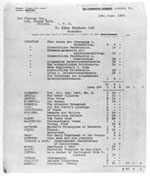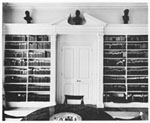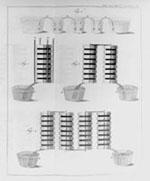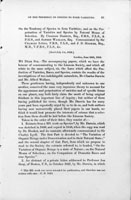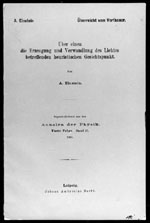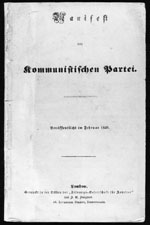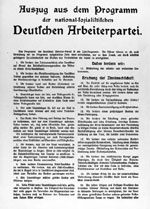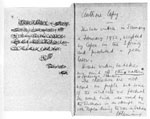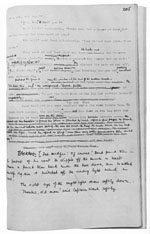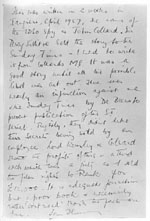His collection first came to public notice when the IPEX
exhibition,Printing and the Mind of Man, was held in London
in 1963. This was unquestionably as claimed, "the most impressive collection of
books ever gathered under one roof." Sixty-three libraries and individuals from
over a dozen countries lent over four hundred titles. Of these about 10 percent
came from the Fleming collection (forty-four), exceeded only by King's College,
Cambridge (fifty-one), and followed by Lilly Library's thirty-one. The
exhibition began with the only known surviving proof sheet of the Gutenberg
Bible, lent by the Lilly Library, and ended with Churchill's famed "Battle of
Britain" speech, 1940.
The Fleming contributions included two books of the 18th, twenty-nine of the 19th
and thirteen of the 20th centuries. All of these, with their original
descriptions, are printed in Part I of this catalogue. Though he had many other
books which were also included in the exhibition, this portion is restricted to
only those which were actually exhibited. Part II is an attempt to show
something of the variety of subjects in which he was interested, aside from the
conventional high-spots. He was passionately interested in ideas: books which he
said "started something," or "made things happen."
It was, four decades ago, an unexplored field. The earlier traditional
"milestones" didn't interest him very much, as, even at that time, he couldn't
or wouldn't pay the going price for them. But he assembled, under the guidance
and with the help ofPercy Muir, his oldest and closest friend in
the book world, not only asJohn Hayword recorded "the primary
printed sources for the great discoveries, inventions, and scientific theories
of modern times ... but also a fascinating selection of minor treatises." And he
added: "We hope [the collection] may be preserved intact. It is of immense
educational interest and should be on permanent exhibition in the youth-thronged
halls of London's Science Museum."
Indeed, during the prolonged negotiations before the Lilly Library acquired the
collection, there were serious doubts that an export license could be obtained
for the books and manuscripts. Happily these fears proved groundless.
The fullest account of why, how, and from whom Fleming acquired the books
isPercy Muir's article in The Book Collector,
Spring, 1965. Though the idea was Fleming's, the work was Muir's, and the
collection was made in a remarkably short time, largely concentrated in the last
half-decade of the 1930's. Muir comments: "It would be invidious for me to speak
too highly of the collection. Suffice it to say that in its formation is one of
the proudest achievements of my life."
When Fleming lost interest in collecting, the writer of these notes attempted,
through John Carter, then Scribner's London agent and a long- time friend of Fleming (they were at Eton together), to
purchase the collection. However, the wily Fleming preferred to let it sit in a
London depository as a hedge against inflation. In this he was right. After his
death, the books were left in trust for his son; eventually, through the good
offices of Percy Muir, head of the famed rare book shop Elkins
Mathews, Ltd., of which, incidentally, Fleming was a Director, they came to
Indiana University.
Space limitations allow the exhibition of about a hundred and fifty (of the more
than a thousand) books in the collection. Forty-four of these, as is mentioned,
were in thePrinting and the Mind of Man exhibition and form Part
I of this catalogue.
The selection of Part II, about one hundred representative works from the
remainder of the collection, presented a problem. We finally decided to
eliminate literature entirely, as well as most of the well-known works in
mathematics, medicine, science (which are often exhibited), and to show in
arbitrary groups, some "minor treatises" less often seen or indeed, even now, collected.
The Fleming Collection
Modern civilization was fashioned in the nineteenth century. It is hardly an
exaggeration to say that the world of 1800 was much closer in its essentials
to prehistoric Egypt than to the world of 1970. Without particularising too
closely one may remark a few indicative details.
Candles were, in 1800, still the commonest form of illumination; horses on
land, and sailing ships at sea were the most efficient forms of traction and
transport. Although steam was not unknown as a source of power, the
commonest use of coal was to burn it in an open grate to heat rooms. The
industrial revolution had begun, but cheap manual labor was responsible for
the vast majority of manufacturing processes, although supplemented by
four-footed beasts where possible.
Communication between distant points could be effected under favorable
circumstances by a chain of visual semaphore stations—to describe which the
word "telegraphy" was devised—even the heliograph had to await the invention
of Morse before its flashes could be built into words. The commemoration of
Paul Revere's ride is a reminder that speedy horsemanship was resorted to in emergency.
In medicine the remedies of quacks and "old wives" were still prescribed by
the profession. Surgeons were classed with barbers, and the unhappy subject
of a major operation, if he survived the shock caused by lack of
anaesthetics or loss of blood, might well succumb to the sequel due to
ignorance of the need for aseptic precautions.
In pure science the position is, perhaps, indicated by the fact that the
science was generally referred to as natural philosophy. Thomas Young,
almost the last of the great dilletantes who dabbled—and in his cases to
some purposes—in almost every branch of science, was as typical of the old
regime as the new class of professional scientist, typified by Davy and
Faraday, was of the new.
The Fleming Collection was an attempt to gather together, in first editions,
the original contributions of the scientists and practical workers, the
total body of whose work has been responsible for the modern revolution.
Thus, in relation to aeronautics, he had the original edition of Lilienthal's
great work on gliding; the first printed papers of the Wright Brothers—which
incidentally pay tribute to the fundamental nature of Lilienthal's
experiments—and Langley's description of his machine, which has strong
claims to having forestalled the Wrights. There is also considerable
supplementary material in the shape of early training manuals, Sir George
Cayley's important paper on airpropellers (1809-1810), etc.
On the telegraph he had the original papers of Wheatstone and Cooke, Ronalds
and Steinheil; while Bell's original description of his invention of the
telephone, although as late as 1876, is one of the principal rarities in the Collection.
On radio there are the original theoretical contributions by Faraday and
Clerk-Maxwell which led directly to the discovery of the waves named after
him by Heinrich Hertz. But the collection also covers the translation of
these theoretical experiments in pure science into the practical sequel of
wireless communications as we know it with, for example, Marconi's own
description of his "detector," read to the Royal Society in 1902, and
Fleming's first announcement of the valve that eventually made broadcasting
a possibility—Royal Society, 1905.
But, generally speaking, the principle upon which the collection was based is
a recognition that invention tends more and more to result from the
practical application of some phase of advance in pure scientific theory;
that is to say, of a discovery in pure science which has a wider and deeper
significance than the particular gadget devised from it, which may become
frontpage news.
In no sphere of activity is this more obvious than in the realm of atomic
fission, the history of which is covered from its very onset and in the
closest detail in this collection, and which includes a number of papers of
the utmost rarity, judged by any standard.
The foundation stone was laid by Rontgen in the two papers of 1895-6
describing the X rays. Becquerel guessed that these rays were not unique and
discovered radio-activity in uranium. His assistant, Madame Curie, and her
husband carried the investigation further and isolated radium.
Meanwhile, theoreticians like Lorentz and Thomson, following up experiments
with cathode tubes by Crookes and Lenard, had discovered the electron (which
was christened by Stoney), and Ramsay, Aston, Soddy, Moseley, and others had
made further progress based on the Curie and Thomson discoveries, which
enabled Rutherford and his associates finally to split the atom. In the
collection, every single step in this process is fully covered by means of
the original material, and with a wealth of detail impossible to mention
here; included as well is the early background of the atomic theory, with
its original pronouncement by Dalton; the compilation of atomic tables by
Newlands, Meyer, and others; and the closely relevant relativity theory,
with all Einstein's papers and those of his associates, Minkowski, Lorentz,
and Millikan; the original account of the Michelson-Morley experiment, which
can be accounted for on no other ground; the background work of Robert Brown
(Brownian movement), van't Hoff, and others; and the discovery that
Euclidean geometry did not work in practice, with the devising of a new
geometry that does, by Lobatschewski.
This is perhaps, and fittingly, the most strikingly and thoroughly complete
of all sections of the library and it is notable here, as elsewhere, that a
large number of the papers and books contained in it won Nobel Prizes for
their authors.
But whether in the development of the germ-theory of disease—with the major
contributions of Pasteur, Koch, Lister, Schick, Wassermann, Ross, Ehrlich,
Metchnikoff, and others; of economic theory and sociology with Moore, Marx
(including the very rare first issue of the "Communist Manifesto"), Engels,
and Lenin (a remarkable collection of original material) on the one hand, or
Hitler ("Mein Kampf" and the exceptionally rare programme of the Nazi party
on a throw-away) and his background, Fichte, Gobineau, Stewart-Chamberlain,
and Richard Wagner, on the other hand; of evolution, with Darwin (not only
the "Origin" of 1859), Lyell, Lamarck, W.C. Wells, Chambers, Mutton, and
other forerunners; of mathematics, with almost every single figure of
consequence during the period— Laplace, Charles, Euler, Gauss, Crassmann,
Cauchy, W. R. Hamilton, Crelle, Hankel, Plucker, Staudt, Weber, Booke,
Dedkind, Steiner, etc.; of psychology and psychiatry, with Freud (all the
important books in first editions), Jung, Pavlov, Watson ("Behaviourism")
Chariot, Binet (deviser of the "I.Q."), William James, Braid, Bernheim,
Prichard (moral insanity), Pinel, etc., etc., etc.—in almost every direction
the collection is amply representative.
Near the end of Fleming's collecting, an attempt to represent the important
literary figures of the period was begun. Although it did not progress very
far, this section includes first editions of Goethe (including the rare
first issue of "Werther"), Byron ("Childe Harold"), Balzac, Butler, Dickens,
Maeterlinck, Maupassant, Lautreamont ("Le Conte de Maldoror," now claimed by
the surrealists as their foundation work), Pater, Kipling, Proust, Rilke,
Schiller, Schnitzler, Scott, Gertrude Stein, Stevenson, Strachey, Synge,
Tennyson, Tolstoi, Turgenev, Zola, etc.
It should be emphasized that, in every case where literary, scientific, or
philosophical works are concerned, the books are in the language in which
they were originally issued.
Every item in the library is preserved in a fleece-lined buckram box, with a
morocco lettering-piece of a color to indicate the section to which it
belongs: red for sociology, orange for pure science, green for medicine, and
so on.
Muir has recorded that he "grudged the money spent on boxes instead of books," as
does the undersigned.
David A. Randall
Librarian, The Lilly Library.
